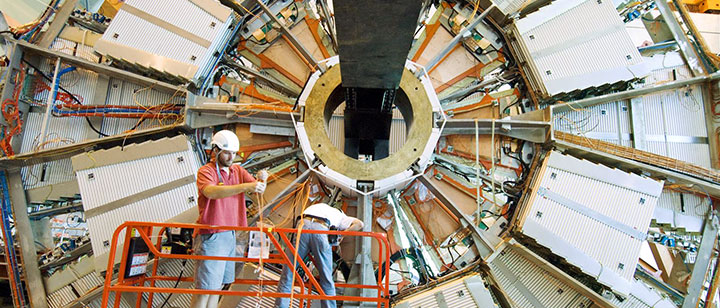Brookhaven and ATLAS

BNL scientists helped install cathode strip chambers — designed and built at the Laboratory — and monitored drift tubes into the ATLAS small wheel. Image credit: CERN.
Brookhaven physicists and engineers are participating in one of the most ambitious scientific projects in the world—constructing, operating, doing physics analysis of the data, and upgrading a machine the size of a seven-story building that has opened up new frontiers in the human pursuit of knowledge about elementary particles and their interactions.
The machine, dubbed ATLAS, is one of four facilities located at the LHC near Geneva, in Switzerland. The LHC consists of two circular vacuum pipes nearly 17 miles in circumference in which protons travel in opposite directions and collide at nearly the speed of light with a total collision energy of up to 14 trillion electron volts (14 tera-electron volts, TeV).
ATLAS is designed to detect particles created by the proton-proton collisions. One of its main goals was to look for a particle called the Higgs boson, which is the source of mass for all elementary particles. The discovery of the Higgs was announced on July 4, 2012, and the theorists predicting its existence were honored with the Nobel Prize in physics in 2013. Further experiments at ATLAS will reveal more details about the mechanism by which this particle imparts mass to elementary particles, and may also offer insight into new particles and physics theories, as well as a better understanding of the origin of the universe.
Brookhaven is the headquarters for the 47 U.S. institutions contributing to the project (see a complete list). In total, 178 laboratories and universities around the world are involved in the ATLAS collaboration.
The ATLAS detector has a cylindrical shape with layers stacked onto each other, like the layers of a cylindrical onion. Each of the layers detects different properties of particles. When particles from the accelerator collisions are produced in the center of ATLAS, they move throughout the experiment and are detected by its successive layers.


